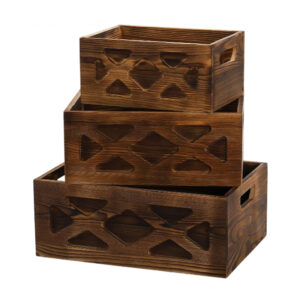One such seemingly simple yet incredibly versatile tool is the nested boxes. Although they might appear to be just a set of boxes that fit into one another, boxes have a wide range of applications that extend far beyond mere storage. From organizing physical items to structuring digital data and even conceptualizing abstract ideas, boxes offer a wealth of benefits across different domains. Let’s delve into the multifaceted world of boxes and explore their diverse uses.
The Anatomy of Nested Boxes
At its core, a nested box is a set of boxes that decrease in size, with each box fitting snugly inside the next larger one. This design allows for compact storage and efficient use of space. The largest box serves as the outermost layer, while the smallest box is the innermost one. Nested boxes can be crafted from various materials such as cardboard, wood, metal, or plastic, depending on their intended use. Each box often comes with a lid or cover, which may be hinged or removable.
Practical Applications of Nested Boxes
1. Storage Solutions:
One of the most common uses of boxes is in storage. Whether you’re moving to a new home or simply decluttering your living space, nested boxes offer a convenient way to pack and organize your belongings. The ability to nest boxes within one another maximizes space and makes transportation easier. For instance, nesting boxes within larger boxes reduces the amount of wasted space, allowing you to efficiently utilize every inch of available room.
2. Gift Packaging:
Nested boxes are also popular for gift packaging. The element of surprise is amplified when a series of beautifully decorated boxes are stacked inside one another. This approach not only adds a touch of elegance but also creates a delightful unwrapping experience for the recipient. Each layer can be customized with different colors, patterns, or messages, enhancing the overall presentation of the gift.
3. Display and Decoration:
In home decor, nested boxes can serve as both functional and aesthetic elements. They can be used to store small items or as decorative pieces themselves. For example, a set of nested boxes might be arranged on a shelf or tabletop, adding a stylish touch while providing a way to keep clutter out of sight. The variety of designs available means that nested boxes can complement virtually any decor style, from modern and minimalist to vintage and eclectic.
Nested Boxes in the Digital Realm
1. File Organization:
In the digital world, nested boxes represent a hierarchical file structure, commonly referred to as nested folders. This system mirrors the physical nesting concept and allows for organized data management. By grouping related files into folders within folders, users can efficiently manage and navigate through large volumes of data. For example, a main project folder might contain subfolders for different phases of the project, each with its own set of related documents.
2. Software Development:
Nested structures are also prevalent in software development. Programmers use nested boxes in the form of nested classes, functions, or objects to organize code logically. This modular approach enhances code readability, maintainability, and reusability. For instance, a class might contain nested classes that handle specific functionalities, or a function might include other functions to manage complex tasks.
Abstract Applications of Nested Boxes
1. Mathematical and Logical Concepts:
In mathematics and logic, nested boxes can represent hierarchical relationships, such as sets within sets or nested logical arguments. This concept is useful for illustrating complex relationships and dependencies. For example, in set theory, you might have a set that contains other sets, each of which can further contain additional sets. This nesting helps to clarify the structure and relationships between different elements.
2. Project Management:
Nested boxes are also applicable in project management. Tasks and subtasks can be organized in a nested format to reflect their dependencies and relationships. This structure helps project managers track progress, allocate resources, and ensure that all aspects of the project are completed in an organized manner. For instance, a main task might have several subtasks, each of which can be broken down further into smaller, more manageable steps.
The Appeal of Nested Boxes
What makes nested boxes so appealing is their combination of functionality and elegance. They offer a practical solution for managing space and organizing items, while also providing opportunities for creative expression in packaging and decor. The ability to seamlessly integrate into various aspects of life—whether physical, digital, or abstract—makes nested boxes a versatile and invaluable tool.
In summary, nested boxes are much more than simple containers; they are a testament to the power of thoughtful design and organization. From efficiently packing and presenting gifts to structuring complex digital data and abstract concepts, boxes prove that even the most basic objects can have profound and far-reaching applications. So next time you encounter a set of boxes, take a moment to appreciate their versatility and the myriad ways in which they enhance our lives.


